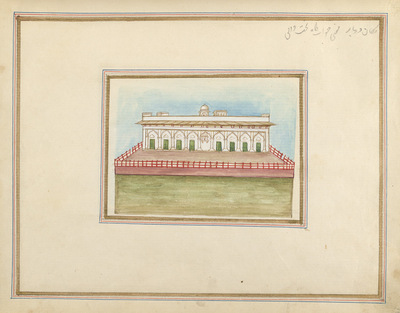Javascript must be enabled to continue!
Bari Khwabgah behind the Diwan-i-Am, Lahore
View through Europeana Collections
Watercolour drawing of the Bari Khwabgah in
Lahore, by an anonymous artist working in the Punjab style, c.1860.
Inscribed in Persian characters is: 'Makan i darbar ya'ni khwabgah
i takht-wali' (The durbar hall, that is the sleeping place of the
ruler).Lahore is the site of the first Mughal settlement in India
and was of strategic importance for the empire. Akbar built this
fort atop an earlier fort on the site and his successors Jahangir,
Shah Jahan, and other Mughal, and later Sikh, rulers made
revisions, replacing many of the original buildings while
maintaining the structure. The fort has two distinct sections: the
private or residential section, located along the northern half of
the fort, and the administrative section which includes areas for
royal audiences. The Bari Khwabgah, or 'large bedroom', is
attributed to Jahangir's period and is located in the residential
section.
Title: Bari Khwabgah behind the Diwan-i-Am, Lahore
Description:
Watercolour drawing of the Bari Khwabgah in
Lahore, by an anonymous artist working in the Punjab style, c.
1860.
Inscribed in Persian characters is: 'Makan i darbar ya'ni khwabgah
i takht-wali' (The durbar hall, that is the sleeping place of the
ruler).
Lahore is the site of the first Mughal settlement in India
and was of strategic importance for the empire.
Akbar built this
fort atop an earlier fort on the site and his successors Jahangir,
Shah Jahan, and other Mughal, and later Sikh, rulers made
revisions, replacing many of the original buildings while
maintaining the structure.
The fort has two distinct sections: the
private or residential section, located along the northern half of
the fort, and the administrative section which includes areas for
royal audiences.
The Bari Khwabgah, or 'large bedroom', is
attributed to Jahangir's period and is located in the residential
section.
Related Results
Blessing Bishop (Saint Nicholas of Bari)
Blessing Bishop (Saint Nicholas of Bari)
Poplar paint gilt, Central Italian...
The Beloved Arrives at Midnight (painting, recto; text, verso), folio 54 from a manuscript of the Divan (Collection of Works) of Anvari
The Beloved Arrives at Midnight (painting, recto; text, verso), folio 54 from a manuscript of the Divan (Collection of Works) of Anvari
The recto side of the folio features two columns of Persian text written in black ink and nasta’liq script. The columns are interrupted by a painting depicting a male figure in the...
"Emperor Babur Receiving a Visitor", Folio from a Baburnama (The Book of Babur)
"Emperor Babur Receiving a Visitor", Folio from a Baburnama (The Book of Babur)
Ink opaque watercolor and gold on paper...
Recent Results
“Sketches of Spain”: Richard Wright's Pagan Spain and African-American Representations of the Hispanic
“Sketches of Spain”: Richard Wright's Pagan Spain and African-American Representations of the Hispanic
At the start of Pagan Spain (1957), Richard Wright recalled a 1946
conversation with Gertrude Stein; she encouraged him to visit Spain:
“ ‘You'll see what the Western world is mad...
Libro de horas de Leonor de la Vega
Libro de horas de Leonor de la Vega
This parchment manuscript from the second half of the 15th century, written in Flemish, is one of the richest examples today of the Books of hours and their illuminations style and...
PARTIZIPATIVE
MUSEUMSARBEIT
IM FHXB
FRIEDRICHSHAINKREUZBERG
MUSEUM
IN BERLIN
PARTIZIPATIVE
MUSEUMSARBEIT
IM FHXB
FRIEDRICHSHAINKREUZBERG
MUSEUM
IN BERLIN
Im vorliegenden Aufsatz werden am Beispiel des
FHXB Friedrichshain-Kreuzberg Museums in Berlin Chancen
und Risiken partizipativer Museumsarbeit diskutiert. Welche
Konsequenzen hat ...











 Your session has timed out for security reasons.
Your session has timed out for security reasons.